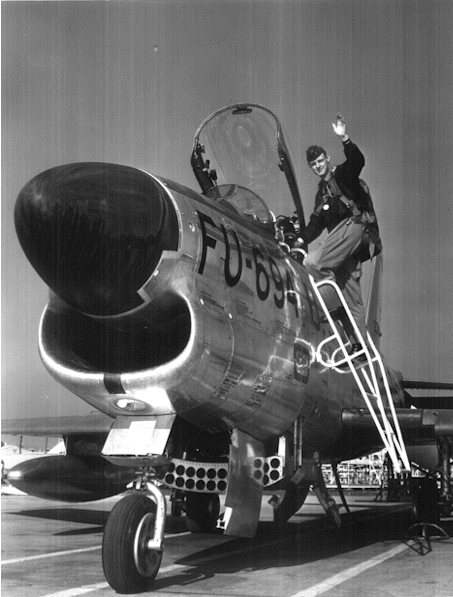
Here he is getting into an F-86D. He loved flying these planes.
Elvin F. Knotts -- Air Force Years
(This page contains several graphics and may take a while to download.)
Elvin Knotts served in the United States Air Force from January, 1951 to November, 1956. During those six years, he had a number of accomplishments. You should see his eyes light up when he tells some of his old Air Force stories.

Here he is getting into an F-86D. He loved flying these
planes.
The F-86D was known for two historic firsts. It was the first USAF airplane to have all-rocket armament, and the first all-weather interceptor to carry only one person for operating the radar fire control system as well as piloting the airplane. It also had the unique distinction of succeeding itself in setting a new world's speed record -- 698.505 mph on November 19, 1952 and 715.697 mph on July 16, 1953.
You can see from the picture that it was no small plane. Here are the specs:
Span: 37 ft. 1 in.
Length: 40 ft. 4 in.
Height: 15 ft. 0 in.
Weight: 19,975 lbs. loaded
Armament: Twenty-four 2.75 Mighty Mouse folding fin aircraft
rockets (FFAR)
Engine: One General Electric J-47 turbojet of 7,650 lbs. thrust
Cost: $344,000
Crew: One
Maximum Speed: 715 mph
Cruising speed: 550 mph
Range: 800 miles
Combat Ceiling: 50,000 ft.
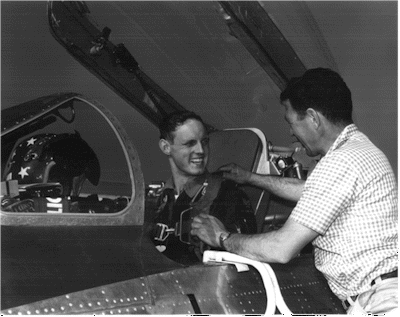
Check out the smile!
On his second flight in an F-86D, Elvin Knotts became a member of the Mach Buster Club by piloting the aircraft in a vertical dive faster than the speed-of-sound on February 25, 1954. He would have been one of the relatively few to fly faster than the speed-of-sound at that point in time because only a few airplanes were capable of supersonic flight. As a matter of fact, the reason he put the plane in the vertical dive was to make it go fast enough to break the sound barrier. That meant that he was dropping more than 1,000 feet per second.
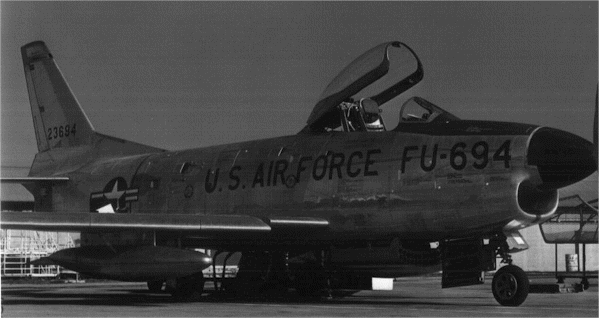
They don't look near this big when they're flying in formation, do they?
Flying as a Fighter Interceptor Pilot is one of Elvin Knotts' most memorable accomplishments. He flew the F-86D as an all-weather fighter-interceptor pilot in the 444th Fighter Interceptor Squadron in the 35 Air Division of the Eastern Air Defense Command at Charleston Air Force Base in Charleston, South Carolina. He spent every fourth week on alert duty where he was required to be airborne in 5-minutes when scrambled. He intercepted aircraft ranging from the Piper Cub to the B-52 at altitudes from 500 feet to 45,000 feet or more at speeds from 100 mph to high-subsonic in all kinds of weather and with navigation and communication equipment not as good as the equipment found in many Cessna 172's today. When not on alert duty, he trained by making day and night radar practice intercepts, fired rockets at tow targets, upgraded instrument and formation flying skills, and participated in other training activities including rides in the altitude chamber to pressure altitudes in excess of 35,000 feet.
~ ~ ~
United States Air Force Flight Training
But, of course, he didn't start out in the single-seat F-86D. In October, 1952, he started 13 months of USAF flight training. He trained in the T-6, the T-28 and the T-33.
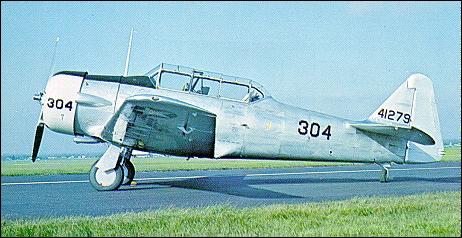
North American T-6G "Texan"
Span: 42 ft.
Length: 29 ft. 6 in.
Height: 10 ft. 10 in.
Weight: 5,617 lbs. loaded
Armament: None (some AT-6's used for gunnery/bombing training)
Cost: $27,000
Maximum speed:
210 mph
Cruising speed: 145 mph
Range: 770
Service Ceiling: 23,200 ft.
The AT-6 advanced trainer was one of the most widely used aircraft in history. Evolving from the BC-1 basic combat trainer ordered in 1937, 15,495 Texans were built between 1938 and 1945. The USAAF procured 10,057 AT-6'; others went to the Navy as SNJ's and to more than 30 Allied nations. Most AAF fighter pilots trained in AT-6's prior to graduation from flying school. Many of the "Spitfire" and "Hurricane" pilots in the Battle of Britain trained in Canada in "Harvards," the British version of the AT-6. To comply with neutrality laws, U.S. built Harvards were flown north to the border and were pushed across.
In 1948, Texans still in USAF service were redesignated as T-6's when the AT, BT and PT aircraft designations were abandoned. To meet an urgent need for close air support of ground forces in the Korean Conflict, T-6's flew "mosquito missions" spotting enemy troops and guns and marking them with smoke rockets for attack by fighter-bombers.
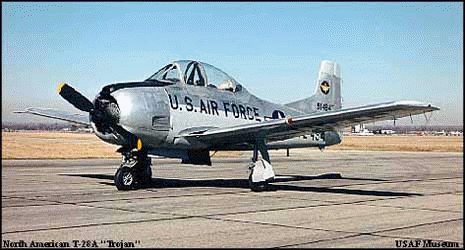
North American T-28A "Trojan"
Span: 40 ft. 7 in.
Length: 32 ft.
Height: 12 ft. 8 in.
Weight: 7,812 lb without external load
Armament: Two .50-cal. machine guns in detachable pods under wing,
two 100-lb. bombs, or six 2.25 in. rockets
Cost: $123,000
Maximum speed:
283 mph
Cruising speed: 190 mph
Range: 1,000 miles
Service Ceiling: 25,200 ft.
The first T-28 made its initial flight on September 24, 1949. Designed as a replacement for the T-6 trainer, the "Trojan" went into production in 1950. The USAF version (T-28A) was powered by an 800-hp. engine, whereas later U.S. Navy versions (T-28B and C) were powered by 1,425-hp. engines. When production ended in 1957, a total of 1,948 of the three different versions had been built.
In 1962, the USAF began a program to modify more than 200 T-28's as tactical fighter-bombers for counterinsurgency warfare in Vietnam. Equipped with 1,425-hp. engines, these airplanes (redesignated the T-28D "Nomad") proved to be an effective weapon in close air support missions against enemy troops inside South Vietnam.
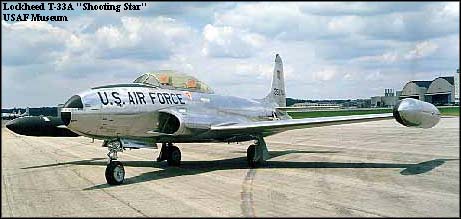
Lockheed T-33A "Shooting Star"
Span: 37 ft. 6 in.
Length: 37 ft. 8 in.
Height: 11 ft. 7 in.
Weight: 15,000 lbs. max.
Armament: Two .50 cal. machine guns in nose
Crew: Two
Cost: $123,000
Maximum speed:
525 mph
Cruising speed: 455 mph
Range: 1,000 miles
Service Ceiling: 45,000 ft.
The two-place T-33 jet was designed for training pilots already qualified to fly propeller-driven aircraft. It was developed from the single-seat F-80 fighter by lengthening the fuselage slightly more than three feet to accommodate a second cockpit.
Originally designed the TF-80C, the T-33 made its first flight in March 1948. Production continued until August 1959 with 5,691 T-33's built. In addition to its use as a trainer, the T-33 has been used for such tasks as drone director and target towing, and in some countries even as a combat aircraft. The RT-33A version, reconnaissance aircraft produced primarily for use by foreign countries, had a camera installed int he nose and additional equipment in the rear cockpit.
The T-33 is one of the world's best known aircraft, having served with the air forces of more than 20 different countries for almost 40 years. Many are still in use throughout the world.
~ ~ ~
Elvin Knotts was commissioned
as a Second Lieutenant in the United States Air Force
and received his wings as a pilot on November 2, 1953.
~ ~ ~
 |
 |
 |
 |
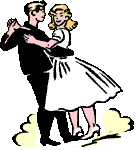 |
| Home Page | Growing Up Years | Air Force Years | NASA Years | Retirement Years |
___________________________________
Elvin Knotts can be contacted at knottsep@earthlink.com.
This is a WebWink website. Direct questions or comments to Escobedo@webwink.com .